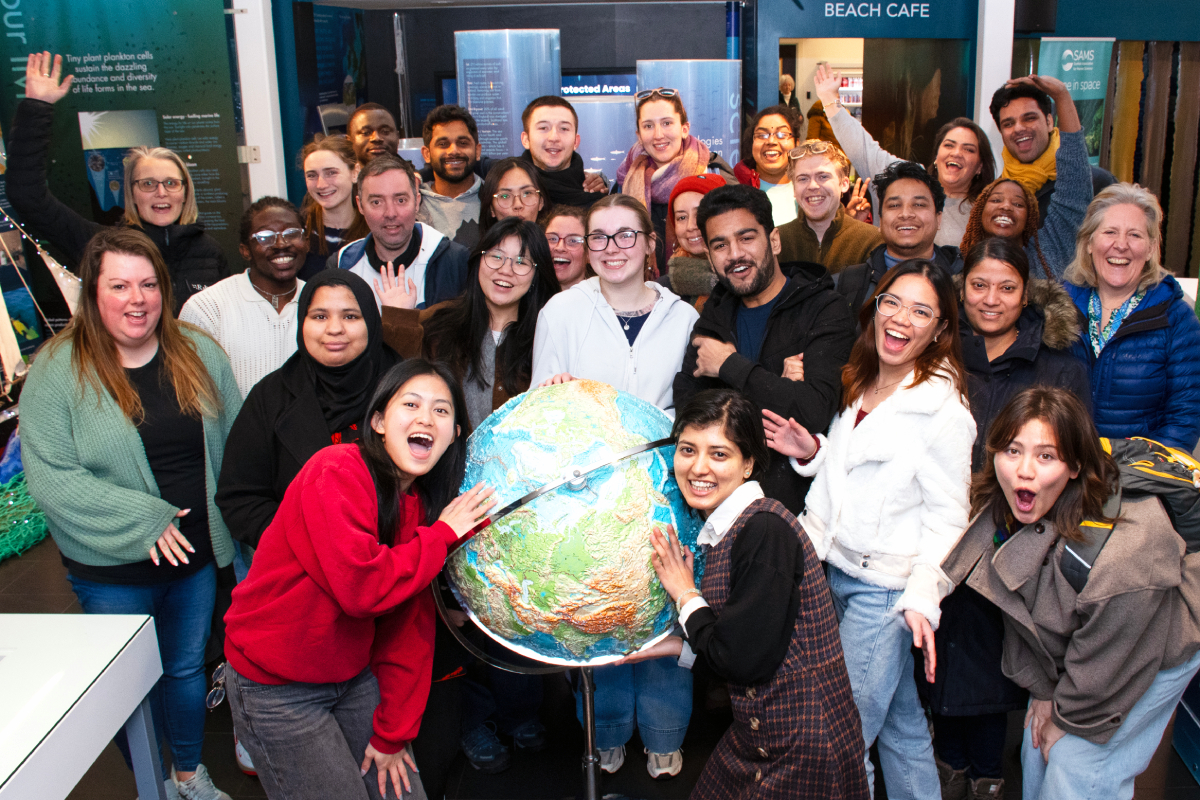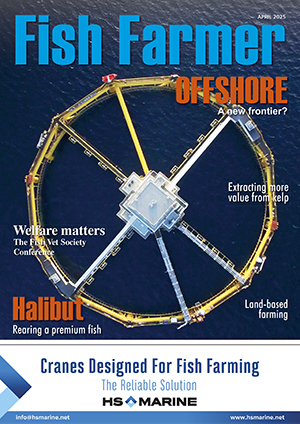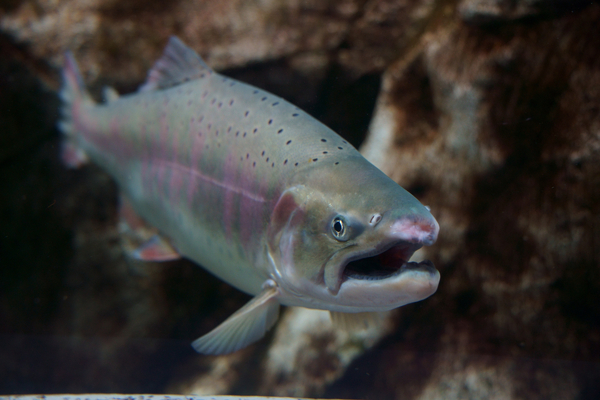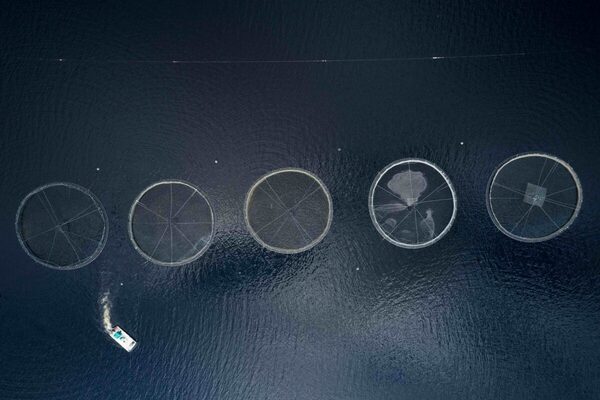Riding the hype cycle
In the last 50 years, fish farming in Scotland has changed, writes Professor Adam Hughes. It has innovated to such an extent that modern salmon aquaculture is now barely recognisable as the same industry it evolved from.
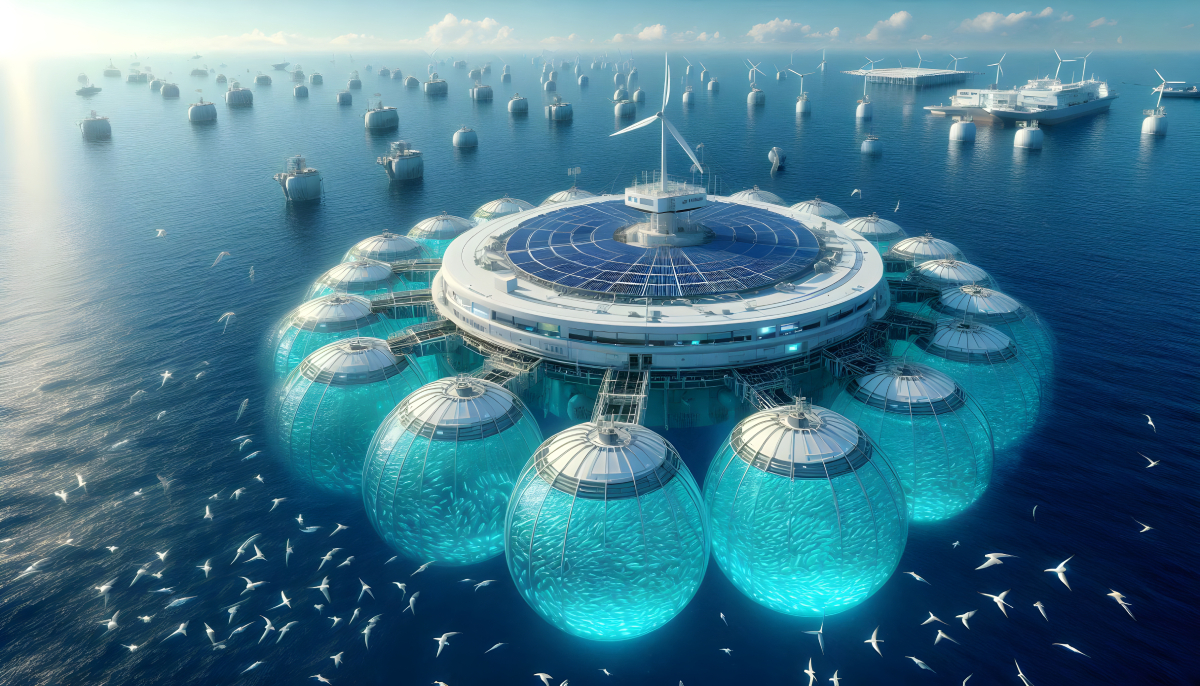
When we were designing the curriculum for our Erasmus Mundus Masters in Aquaculture, Society and Environment (ACES) at the Scottish Association for Marine Science (SAMS) back in 2014, we wanted to reflect how important innovation was to the industry and to ensure our students understood how it occurs. After all, they are the next generation of aquaculture innovators.
We designed a module titled Innovation, Technology and Systems to help the students develop a systems-based approach to aquaculture innovation and entrepreneurship. We are now in our 10th year and have trained more than 180 students from 49 countries, and the module continues to be a popular choice.
As part of this module we study a range of ways in which innovation can be thought about and the processes which allow it to happen. We also identify the factors that lead to innovations being adopted and the journey to everyday use. One way we look at this is by using the Gartner Hype Cycle Model.
The hype cycle is a graphical depiction of how technological innovations are thought about, as the technology matures. Gartner, an American research and advisory firm, developed the hype cycle to analyse the global innovation scene and every year it produces a hype cycle describing current trends.
The hype cycle does not reflect how good the innovations are, but maps out the stages of external perceptions of those innovations. This is important information for innovators, potential adopters of the technology and investors. It helps them recognise the state of maturity of the innovation and to understand that all innovations naturally go through five stages.
1. Technology Trigger: A potential technology breakthrough occurs, sparking significant publicity through early proof-of-concept stories and media interest. At this stage, usable products are often non-existent, and commercial viability is unproven. It begins with R&D, start-ups, lab prototypes and mass media interest
2. Peak of Inflated Expectations: Early publicity leads to numerous success stories, often alongside failures. Some companies engage with the innovation (early adopters), but most do not. These are first-generation products, often expensive and have a need for customisation for each new application
3. Trough of Disillusionment: Interest declines as experiments and implementations fail to deliver at a large scale. Technology producers may fail or drop out. Investment continues only if the remaining providers improve their products to satisfy early adopters. Media coverage concerns problems and failures, causing the technology to become unfashionable.
4. Slope of Enlightenment: Instances of the technology’s benefits become clearer and more widely understood. Technology providers offer second and third-generation products. More enterprises fund pilots, while conservative companies remain cautious. Fully commercial iterations become available
5. Plateau of Productivity: Mainstream adoption begins and criteria for assessing provider viability are more clearly defined. The technology’s broad market applicability and relevance become apparent.
This year, our ACES students built a hype cycle for the Scottish salmon industry using the last four years of Fish Farmer magazine as source material (Figure 1). To do this we split the back issues of the magazine up amongst the class and then each student went through their copies of the magazine finding all the innovation they could.
We then tried to group these innovations into approximately 15-20 different types of technologies. Once we had this list, the next step was to assign the innovation to a place on the hype cycle. As expected, there was a lot of discussion and not a lot of agreement. It is important to remember the hype curve is not about the merits of an innovation, but where it is on its journey to adoption by the industry and how people currently perceive that innovation.
Take artificial intelligence, for example. You might think it will solve a range of problems and make our society better, or you might think that it is only useful for generating strange art, and for students to take short cuts when writing essays. The difference is how we perceive it.
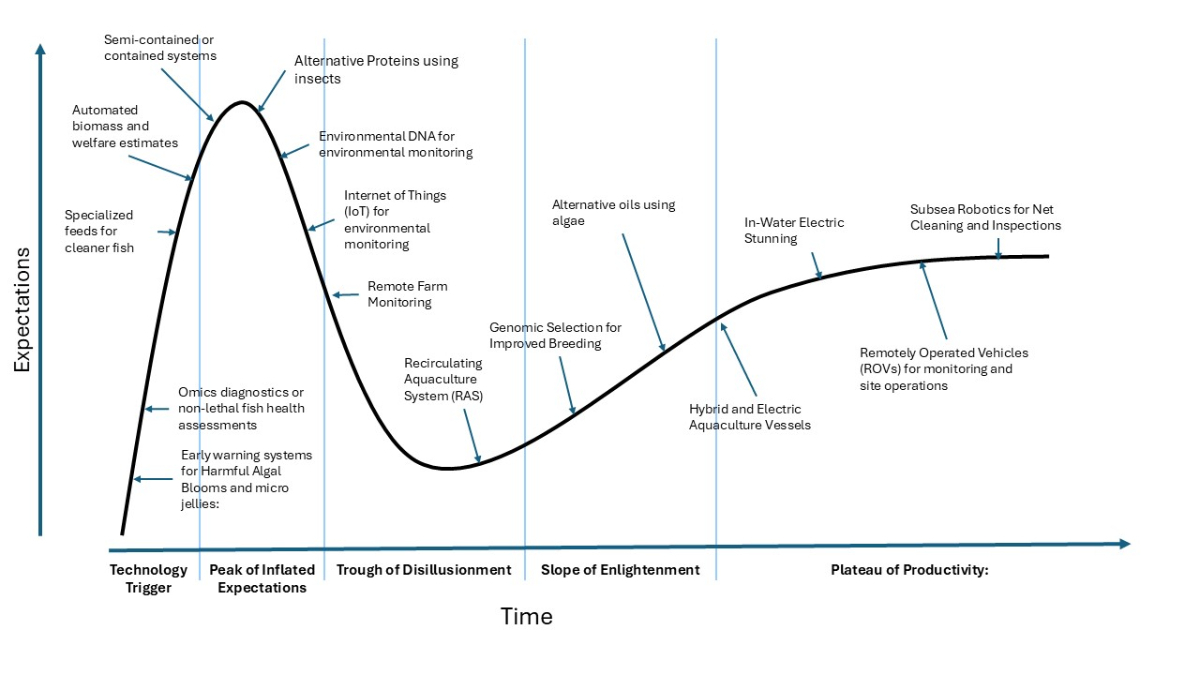
The technologies we identified were:
• Automated biomass and welfare estimates. Camera-based systems use machine learning and algorithms to analyse images of fish populations, providing automatic weight measurements and welfare scoring. This reduces the need for manual handling and helps farmers make informed decisions from an early stage.
• Specialised feeds for cleaner fish. These feeds are designed for lumpfish and wrasse in the pens, accounting for their different feeding behaviours. These feeds can improve cleaner fish health, welfare and efficacy against sea lice.
• Remote farm monitoring. This involves using wireless sensors to provide real-time data on environmental and weather-based factors. Farmers can closely monitor water quality levels, optimise overall farm operations and prioritise fish welfare through user-friendly dashboards.
• In-water electric stunning. This technology ensures less stress during slaughter ensuring higher animal welfare standards and a better end product.
• Hybrid and electric aquaculture vessels. These vessels aim to reduce the reliance on diesel, cutting costs and greenhouse gas emissions.
• Subsea robotics for net cleaning and inspections. Underwater vehicles can efficiently perform tasks such as net checks, maintenance and delivering real-time video for analysis.
• Recirculating aquaculture system (RAS). Land-based aquaculture that recirculates the water multiple times. It includes components such as physical water filters, biofilters, degassers, disinfection and oxygen injection.
• Early warning systems for harmful algal blooms and micro jellies. These systems automate the identification of harmful plankton, enabling fish farmers to take early action to protect their fish.
• Genomic selection for improved breeding. Identifying and selecting specific genetic traits to enhance desirable characteristics – like disease resistance, growth rate and overall health – in farmed species.
• Alternative proteins using insects. As an alternate to fishmeal and soya protein in fish feeds, this involves producing protein meal from insects such as black soldier fly larvae, which can be fed on organic waste.
• Alternative oils using algae. Marine algal oil can offer an alternative as a sustainable replacement for fish oil in aquafeed.
• Semi-contained or contained systems. Designed to provide a more controlled environment than net pens, with the goal of minimising environmental impact and improving fish health. These systems often use impermeable membranes to prevent the entry of sea lice and pathogens while also capturing waste.
• Omics diagnostics or non-lethal fish health assessments. Using technologies such as lipidomic, proteomics or transcriptomics as a non-lethal diagnostic tool.
• Environmental DNA (eDNA). This can be used to examine microbiological and animal biodiversity to help with environmental monitoring especially in the benthic environment surrounding sea cages.
• Microbiome management in fish health including probiotics and prebiotics. Managing the microbiome of farmed fish to support fish health and growth using probiotics and prebiotic technologies in feed.
• Digital twins (advanced computer modelling) for environmental modelling. Using advanced computer modelling, artificial intelligence (AI) and real-time sensor integration to create predictive virtual aquaculture systems.
• Internet of Things (IoT) for environmental monitoring. Involves the use of interconnected sensors and devices to collect and transmit real-time data on various environmental parameters in aquaculture settings.
• Remotely operated vehicles (ROVs) for monitoring and site operations. These uncrewed underwater vehicles can be used for a range of applications including benthic monitoring, mort recovery and infrastructure inspections.
It is important to remember that we were not making judgements about the utility of the technology, or about any specific company’s application of the technology, we were only trying to understand where it was in the hype cycle. As such, where we couldn’t resolve the position, I used some of my background knowledge to make the decision.
It is almost certain that the reader will have a different opinion on the hype curve, which technologies we should have included and their position on the curve, but we thought you might be interested in the seeing what we came up with.
Irrespective of the final positions of any technology, it was a great exercise to stimulate discussion about innovations in the Scottish salmon industry and highlight the high level of technology in the sector. With a special thanks to the hard work on this by our students: Aakriti Maraseni; Alessio Nembrini, Divine Anjorin, Maria de la Cruz Campos Mas, Edna Negron, Cora Filipetti, Danielle Johnston, Diem Phuc Pham, Ayodele Salaudeen, Jocelyn Sutedja, Swapnil Naithani and Zdeněk Velický.
Adam D Hughes is Professor of Innovation in the Blue Economy and Senior Lecturer in Sustainable Aquaculture with UHI (the University of the Highlands and Islands).
